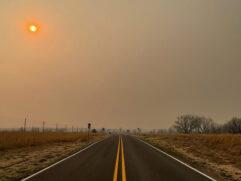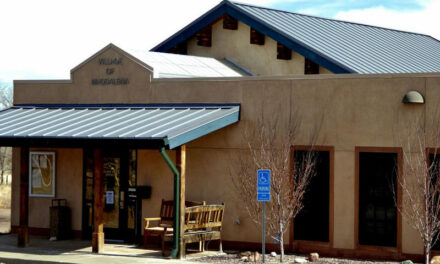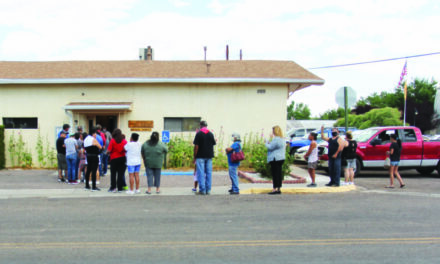
State Road 161 north of Las Vegas, pictured Sat. April 23, 2022. The United States Forest Service on Thursday announced results of a review of prescribed burns, following the escape of a burn here that ultimately grew to the biggest in state history. (Photo by Patrick Lohmann / Source NM)
The United States Forest Service announced big changes to the way it will authorize prescribed burns in light of mistakes the agency made in igniting what became the biggest wildfire in New Mexico’s recorded history.
The agency released a 107-page review of its prescribed burn practices on Thursday. It came after a 90-day pause on prescribed burns across the country ordered after such burns escaped in New Mexico. The fires the agency set fed on drought and dry conditions, and went on to consume homes, forcing thousands to flee.
The agency then halted burns nationwide to ensure protocols were adequate. While prescribed burns rarely escape, Forest Service Chief Randy Moore acknowledged in the report, one errant blaze can be disastrous for everyone nearby.
“We cannot underestimate how destructive prescribed fire escapes can be,” he wrote in the introduction of the agency’s findings.
Now that the review is complete, prescribed burns can begin again across the country, Moore wrote. But federal forest managers will first need to review all existing plans for burns in their areas, even plans that were completed recently.
In addition, top officials who authorize burns will need to consider more factors before they’re allowed to give the OK, and the plans that guide their ignitions will only be effective for 24 hours, not weeks or months, as they were before. So officials will have to re-authorize a prescribed burn the day before it is lit every time.
In the case of the Dispensas burn in New Mexico that became the Hermits Peak wildfire, an administrator signed off on the burn on March 24 to occur between April 1 and April 30. Crews ignited the fire April 6.
Moore approved seven immediate changes to the prescribed burn approvals, and said the agency will make more adjustments down the road.
Seven changes the Forest Service plans to make:
- Review all existing fire plans and complexity analyses to ensure they “accurately reflect current conditions.”
- Standardize ignition approval briefings
- Require officials to re-authorize igniting a burn every 24 hours, instead of allowing for a burn window of weeks or longer
- Before burning, the on-site burn boss will document whether all the conditions on the ground match those that were considered by the forestry official who authorized the burn
- Administrators will be present for all high-complexity burns
- No burns can be conducted until forest supervisors go over the findings from the review with all employees involved
- Moore will designate a Forest Service employee to oversee the implementation of the review across all U.S. Forest Service land
Though the report mentions New Mexico only once, some of changes appear to be direct responses to errors the Santa Fe National Forest made when it lit a fire meant to blaze through a 1,200-acre swath of Las Dispensas earlier this spring, a burn that quickly escaped and was soon after declared the Hermits Peak wildfire.
That fire combined in late April with another escaped prescribed burn in Calf Canyon, that one sparked by a pile burn from January that crews mistakenly thought was extinguished and had stopped monitoring.
Eventually, the Hermits Peak-Calf Canyon wildfire burned more than 340,000 acres. It destroyed communities and landscape around Mora, N.M., which is about 20 miles north of Las Vegas, and has ushered in intense flooding that has caused ongoing damage. The fire was finally deemed 100% contained on Aug. 21.
An interagency review published in July found numerous failings, including that the Forest Service crew was understaffed and ill-equipped if the burn were to escape.
Investigators also found that the crew didn’t have access to remote weather monitoring devices before the burn, and that another crew should have been on-hand in case it escaped but was hours away at a training.
The complexity of the burn was inaccurately deemed “moderate,” according to the review, when it should have been “high” due to the nearby communities and other assets. U.S. Rep. Teresa Leger Fernandez, who represents the burned area, blasted the agency for “undervaluing” her community and successfully pushed for a Government Accountability Office review of the fire, which is still underway.
In the days leading up to the fire, leaders reviewed weather forecasts from the National Weather Service that showed high winds and low humidity, metrics that fell right on the maximum or even exceeded the allowable limits called for in the burn plan.
Thursday’s report said insufficient information about local weather conditions was a cause for recent fire escapes and said officials need to consider weather trends, not just forecasts, on the day a burn is planned.
“Several fire escapes have been related to insufficient information on local weather conditions and forecasts,” the review authors wrote. “The reason can range from malfunctioning remote automatic weather stations to a failure to request spot forecasts and inaccurate spot forecasts.”
According to a copy of the Dispensas pre-burn checklist provided to Source New Mexico in response to a public records request, an administrator said recent snowfall would protect against any escape despite long-term dry conditions, and that the burn should go ahead.
“Although the area is in a drought, we anticipate recent snow events and moist fuel beds will moderate fire behavior,” the official wrote. The document provided to Source redacted the administrator’s name.
Thursday’s review cited failure to heed the impact of long-term drought as another reason prescribed burns escape.
“Insufficient consideration of the impact of long-term drought on prescribed fire behavior: Drought was cited in several reviews of escaped prescribed fires. The impact of drought on prescribed fire behavior will grow in a warming climate,” the authors wrote.
From now on, the burn authorization form for forestry officials has a new question at the top that requires them to say whether drought conditions are worsening, improving or stable.
The form will also require administrators to consider the fire risk in areas next to the planned burn and ensure that the maximum response time for backup crews is no longer than 30 minutes in case the fire escapes.
The review comes after an intense fire season and on the cusp of quadrupling the number of acres subject to prescribed burns and forest thinning on United States Forest Service land. The Forest Service has identified prescribed burns as a key tool to protect the nation’s forests from high-intensity fires that can grow out of control and leave scorched earth in their wake.
“Prescribed burning will be key in treating landscapes to reduce the risk of catastrophic fire to the American people and to the public lands entrusted to Forest Service care. The agency has to do the work — but it has to do it right,” the review authors wrote.
When the Hermits Peak fire was declared, local elected officials like Gov. Michelle Lujan Grisham chastised the federal agency for igniting a blaze during the spring windy season and during prolonged drought. The review does not appear to limit any burns during a particular time of year.
A spokesperson for Lujan Grisham told Source New Mexico that her office is still reviewing the report.
“We appreciate that it appears to be a thorough review,” spokesperson Nora Meyers Sackett said. “We hope the Forest Service understands that it will take actions, not just words, to earn back the trust of New Mexicans.”
While some in New Mexico applauded the review process, one local forest management expert said he feared its conclusions might go too far.
Matt Hurteau previously told Source New Mexico that the 90-day pause occurred when burns could safely be conducted in wetter parts of the country, and he said adding additional onerous regulations on experienced burn bosses might make it even harder to protect the nation’s forests from high-intensity fires.
Story by Source New Mexico



















